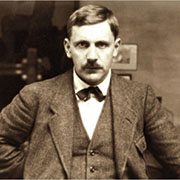The music from Othmar Schoeck’s opera Penthesilea has a tremendous orchestral effect, even without being staged. The suite arranged by Andreas Delfs can be compared to a symphonic poem. It now opens up the possibility of performances of Schoeck’s innovative masterpiece in the concert hall.
Compared with his immense output of lieder, Othmar Schoeck left just a small number of concertante orchestral works scored for large forces: Symphonic movement WoO 25 (1905/06), Overture to William Ratcliff by Heinrich Heine WoO 29 (1908), Präludium for orchestra op. 48 (1932/33) and Festlicher Hymnus op. 64 (1950).
However, in his seven operas, the 14 songs Lebendig begraben op. 40 and the dramatic cantata Vom Fischer un syner Fru op. 43, Schoeck used differently-scored large orchestral formations and proved himself to be an original master of orchestration. In contrast with the opulent opera scores of his contemporaries Franz Schreker and Erich Wolfgang Korngold, his orchestrations were often more powerful and strongly delineated, and therefore more modern-sounding.
This especially applies to the one-act opera Penthesilea op. 39. This is regarded to a large extent as Schoeck’s most important and progressive work. The libretto is based on the original text of Heinrich Kleist’s tragedy. Schoeck condensed this to the essentials and set it to eruptive, deeply moving music. The use of ten clarinets (!), two orchestral pianos and four solo violins (instead of tutti violins) give the full score a completely distinctive sound. Schoeck’s biographer Hans Corrodi talks very appositely of the “bronze-like sound”.
Whilst Richard Strauss, Leoš Janáček and Alban Berg created several extended symphonic excerpts from their stage works for concert use, with the exception of the short Intermezzo from “Don Ranudo” (Serenade for oboe, cor anglais and strings) Schoeck did not make any such arrangements from his operas.
The arrangement of the “Penthesilea” Suite
In May 1991 the Swiss Youth Symphony Orchestra, conducted by Andreas Delfs, recorded Schoeck’s Violin Concerto (quasi una fantasia) op. 21 with soloist Bettina Boller for the Swiss label Claves.
Andreas Delfs was not attracted by the idea of including Schoeck’s op. 48 and op. 64 orchestral works to complete the programme. Instead, he realised a long-cherished plan of making a symphonic arrangement containing the most important passages from the opera Penthesilea specially for the occasion. This arrangement follows precisely the chronology of the original score. For technical reasons of performance, Delfs made some minor alterations in the orchestration, without altering Schoeck’s tonal sound. The original ten clarinets are reduced to six players with changes of instrument, the bass clarinets rescored for bassoons; the four solo violins are scored tutti, with the first desk players taking the original solo parts on several occasions. A few particularly prominent vocal parts are given to orchestral instruments.
Apart from the fact that the young orchestral musicians were not familiar with Schoeck’s musical language, during rehearsals the orchestral material posed a particularly tricky challenge. This had been compiled and stuck together from a short score made by Delfs from photocopied original orchestral material, and then reproduced. Delfs conducted from a copy of a full score in which his alterations to the orchestration, cuts, etc., were marked. During the rehearsals the Suite underwent even more alterations. Obvious mistakes in the notation had to be corrected and additional alterations to the orchestration and performance instructions entered in the parts. Despite the unsatisfactory materials, the recording in August 1991 was a great success, and the CD was well-received in the specialist press. A documentary CD produced by Swiss Radio International at the same time as the Claves release was distributed to radio stations throughout the world and broadcast as a result. Several orchestras soon showed an interest in performing the Penthesilea Suite. But because of the inadequate state of the material, these came to nothing.
On the occasion of the 50th anniversary of Othmar Schoeck’s death, the full score and parts were written out in fair-copy as a research project at the Zurich Hochschule der Künste, and in February 2007 the work was performed again in a joint project with the combined orchestras of the music colleges of Zurich and Geneva conducted by Andreas Delfs in Chur, Geneva and Zurich.
The material was published by Bärenreiter in August 2013. The magnificent music of the opera Penthesilea can now finally be performed in the concert hall.
Lehel Donáth
(from [t]akte 2/2013)



